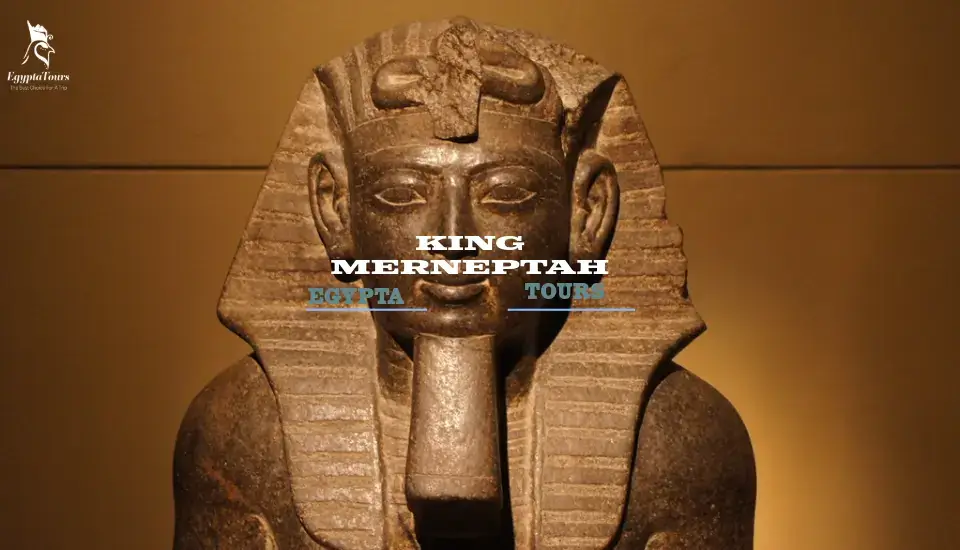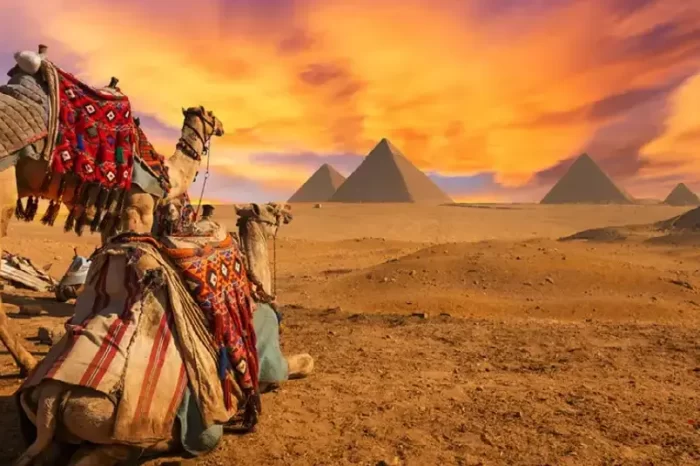King Merneptah, or “the beloved of the Lord Ptah,” is the son of the crown prince of King Ramses II the Great. Merneptah was the thirteenth son of King Ramesses II, who succeeded his long-lived father on the great throne of Egypt, and assumed the rule of Egypt when he was in his seventh decade.
The mummy of King Merneptah, one of the most important kings of ancient Egypt, is currently on display in the Royal Mummies Hall at the National Museum of Egyptian Civilization. It is among 22 mummies that were transferred from the Egyptian Museum in Tahrir to their permanent display location in the National Museum of Egyptian Civilization.
About King Merneptah
King Merneptah (or Merneptah) was the fourth ruler of the 19th Dynasty in ancient Egypt. He ruled Egypt for 10 years between late July/early August 1213 BC.
To May 2, 1203 BC. According to contemporary historical records of his rule. He was the thirteenth son of Ramesses II.
He came to power after the death of all his older brothers, including his brother Khaim Wasat. When he ascended the throne of Egypt, he was approximately 70 years old.
Ramesses II lived until his nineties in good health and was one of the oldest pharaohs in Egyptian history, if not the oldest.
He outlived many of his heirs, and was eventually succeeded by his son Merneptah. Merneptah was prepared to be pharaoh through the responsibilities he assumed in government.
When he reached forty, Merneptah was promoted to superintendent of the army. At five-fifteen, he was officially declared crown prince.
At that point, he was given additional responsibilities by serving as prince regent for the last twelve years of Ramesses II’s life.
Perhaps most famous for it is the King Merneptah Monument, which contains what is believed to be the first known mention of the name Israel. His royal name was Ba-en-Ra Meri-net-geru, meaning “Spirit of Ra, Beloved of the Gods.”
King Merneptah ruled for about ten years, and his reign was documented in three great inscriptions: the first is about eighty lines on a plaque in the temple of the god Amun in Karnak.
The second is a 35-line stella from the region of Atreb, or Penha, in the Delta, and the third is the great victory stela found by the famous British archaeologist Sir William Flinders Petrie in 1896 in the destroyed mortuary temple of King Merneptah in Thebes or Luxor, which consists of 28 lines.
The three panels refer to Merpentan’s military campaigns and complement each other.
King Merneptah and his family
Merneptah was probably the fourth child of Ramesses II’s second wife, Set Nofret I (Isis Nofret), and overall the thirteenth son of Ramesses II.
Set Nofret married the second, who was probably his sister or niece, and she would become his eldest royal wife when he became pharaoh. They had at least two sons, Merneptah and Seti, and his son, Twosret.
When he became pharaoh, his sister, Twosret, was the eldest royal wife, and later she herself would become pharaoh.
He also often married Queen Takht, one of their sons who would later become 19th Dynasty Pharaoh Seti II.
They also had Prince Merneptah and Princess Khaemwaset. One of their other children, most likely, was the usurper of the throne, Amen Masi.
History of the rule of King Merneptah
According to one reading of contemporary historical records, Merneptah ruled Egypt for approximately ten years, from late July or early August 1213 BC until his death on May 2, 1203 BC.
In the fifth year of his reign, the power of the Libu tribe was strengthened with the support of the Meshwesh and the Kahak, as well as their alliance with the Sea Peoples descending from the Aegean Sea to Libya, and creeping east.
On their way to Memphis, Merteptah fought a battle that lasted six hours and culminated in victory over the Libyans and the Sea Peoples at the entrance to Perire, located mostly on the western edge of the Nile Delta.
This campaign against the Sea Peoples and Libo is described in prose on a wall next to the Sixth Pylon at Karnak, and its words read:
The beginning of the victory achieved by His Majesty in the land of Libya] – I, Ekwesh, Tersh, Lucca, Sharden, Shaklesh, the northerners coming from all countries.
An inscription on the Athrib Stele, now in the garden of the Cairo Museum, states that “His Majesty was angry at their report, like a lion,” gathered his court, and made a rousing speech.
Later he dreamed that he saw Ptah handing him a sword and saying, “Take it and keep your fearful heart away from you.” When the archers came out, the inscription says: “Amun had a shield with them.”
Six hours later the nine surviving crossbowmen (enemy) laid down their weapons, abandoned their belongings and families, and ran for their lives.
Merneptah says he defeated the invasion, killing 6,000 soldiers and taking 9,000 prisoners. To confirm the numbers, among other things
He took the penises of all the uncircumcised dead enemies and the hands of all the circumcised ones, from which history teaches that the Aquish were circumcised, a fact that made some doubt that they were Greek.
He seized large spoils of weapons, prisoners, and herds of livestock. It was also necessary to suppress a dangerous rebellion that broke out in Lower Nubia.
To strengthen the Egyptian presence in Palestine, King Merantepah, in the fifth year of his rule, sent military campaigns to three Canaanite cities: Ashkelon, Gezer, and Yenoham.
Among the many texts that praise the Egyptian victories over the Libyans, and refer briefly to those campaigns that were sent to Asia, we find one text in which “Ysiriaro” is mentioned, which some have likened to the word Israel, and it was mentioned not as a country or city, but as a tribe.
Therefore, this painting brought great fame to Pharaoh Merneptah, as the Jews depend on it as the only mention of them in Egyptian antiquities, although the word is not conclusive.
The Death of King Merneptah and his tomb
Merneptah suffered from arthritis and atherosclerosis and died as an elderly man after reigning for nearly a decade.
He was originally buried within Tomb KV8 in the Valley of the Kings, but his mummy was never found there. In 1898 it was located with eighteen other mummies in the mummy cache in the tomb of Amenhotep II (KV35) by Victor Laurier.
His mummy was transported to Cairo and eventually unwrapped by Grafton Smith on 8 July 1907.
Smith points out the following in describing King Merneptah:
The body of an elderly man measuring 1 meter 714 mm tall, Merneptah was almost completely bald, leaving only a small patch of white hair (now clipped so that it can only be seen with difficulty) on the temples and nape.
A few short black hairs (about 2 mils) were found on the upper lip and scattered, cropped hair on the cheeks and chin. The general appearance of the face suggests Ramesses II, but the shape of the cranium and the measurements of the face closely agree with those of his father, Seti the Great.
In 1980, James Harris and Edward Wenty conducted a series of X-ray examinations of the New Kingdom pharaoh’s cranium and skeletal remains, which included the remains of Merneptah’s mummy.
Overall, the analysis found strong similarities between the New Kingdom rulers of the Nineteenth Dynasty and the Twentieth Dynasty with Nubian samples from the Mesolithic.
The authors also note connections with contemporary Mediterranean populations of Levantine origin. Harris and Wente suggest that this represents a mixture because the Ramessides were of northern origin.
In April 2021, his mummy was transferred from the Museum of Egyptian Antiquities to the National Museum of Egyptian Civilization along with 17 other kings and 4 queens in an event called the Golden Parade of the Pharaohs.
Painting of King Merneptah
This painting was discovered in 1896 by the English Egyptologist Flinders Petrie in the funerary temple of king Merneptah and is considered the first of its kind in ancient Egyptian history.
It is one of the most important artifacts, which is (the Victory Stela), which is a memorial plaque for King Merneptah of Egypt, who ruled Egypt between (1213 – 1203 BC), engraved on a thick slab of granite stone.
The plaque mentions the victory of King Amenhotep III over the Libyans and their allies, while it speaks The last three lines are about another campaign in Canaan
Which was part of the Egyptian Kingdom at that time, and was discovered in Thebes – Luxor now, and the painting is now located in the Egyptian Museum in Cairo.
The height of the painting was 310 centimeters, its width was 160 centimeters, and its thickness was 32 centimeters. It was the basis of the Temple of the Dead of Amenophis III of the Eighteenth Dynasty.
On its back was written a report on the constructions carried out by the king in western Thebes, in Soleb, Luxor, and Karnak.
During the Amarna era, part of the formula carved on it was removed, and Pharaoh Setos I of the Nineteenth Dynasty used it after restoration as a memorial plaque for the god Amun.
In the other half of the picture to the left, Merneptah is seen receiving the curved sword “Shebesh” from Amun Ra, followed by the god Mut. In writing on this scene, Amun Ra says
Column of King Merneptah
The Column of King Merneptah, known as the “Mataria Column”, is made of pink granite and is 5.50 meters long.
It was found by the famous Egyptian archaeologist Mounir Basta in the Arab Al-Hisn area in Al-Mataria near the obelisk during the excavations of the Egyptian Antiquities Authority in the years 1967 – 1970.
It is the site It remained there for years before it was moved to Salah al-Din Citadel for restoration. The King Merneptah Column is not the king Merneptah Monument.
The importance of the column stems from the presence of a 4-line text that talks about the great historical victory (the Battle of Pri-Ra) that King Merneptah achieved over the Libyans in the fifth year of his reign at the western end of the Nile Delta. Line 27 of the stela, which says:
No one will raise his head from among the nine arches. Desolation is for Tehnu, and the country of Khita has been silenced, and Canaan has been plundered and all evil has befallen it.
And Ashkelon has surrendered and taken Gezer, and Jenoam has become as if it never existed, and Israel is desolate and no longer has seeds, and Kharu has become a widow of Egypt.”
Some scholars believe, according to their recent studies, that the ancient translation of the word Israel is wrong and that it should be translated as “Yisriyaro,”
Which means the inhabitants or tribes of the Jezreel Plain of Jezreel, which is “Marj Ben Amer” on the eastern-north side of Mount Carmel, which extends from Haifa in the west to the Wadi Jordan.
check this tour packages
- Egypt Tours Packages from USA
- Egypt Tours from Canada
- Egypt Tours from Singapore
- Egypt Vacation Packages from Toronto
- Egypt Tour Packages from Australia
- Egypt Tours Packages From Sri Lanka


























































